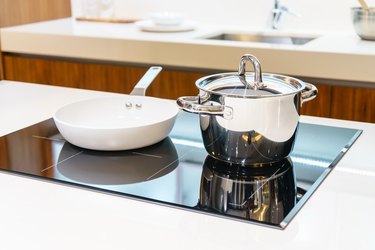
Many cooks like using ceramic pans because of the cookware's consistent heat distribution, nonstick properties and easy cleanup. Ceramic pans are safe for stove top use on electric, gas and ceramic cooktops, and some pans are also oven-safe at temperatures up to 400 degrees F, although they're not broiler-safe.
Ceramic Frying Pan First Use
Video of the Day
You won't have to "season" a ceramic frying pan before its first use as you would for some other types of nonstick cookware; all you have to do is wash the pan in warm, soapy water, rinse and thoroughly dry it. After this first cleaning, effectively using a ceramic frying pan includes properly cleaning it after each use, choosing correct utensils and using a preheating technique for cooking certain foods.
Video of the Day
Types of Ceramic Pans
Some ceramic frying pans, such as those in the Calphalon® ceramic nonstick cookware line, are made of ceramic-coated aluminum or hard-anodized aluminum construction. Another brand, Xtrema®, makes 100 percent ceramic cookware.
Both these brands are PFOA- and PTFE-free. Perfluorooctanoic acid (PFOA) and polytetrafluoroethylene (PTFE) are synthetic chemicals commonly found in other types of nonstick cookware, including Teflon®, which have long been subjects of study to determine potential human health hazards and environmental impact.
Many consumers who prefer to err on the side of caution choose ceramic frying pans as an eco-friendly, nontoxic alternative to other types of nonstick cookware.
Dry Fry Pan Preheat Method
Preheat ceramic cookware by heating a dry fry pan, with no oil or butter, at the setting you'll use when cooking before adding food. It's better not to try to speed up the preheating step by using a higher heat setting.
As a guideline, if you're searing, frying, sautéing or stir-frying, use a medium-high heat setting. If you're making omelets, pancakes, sandwiches or reducing liquids, use a medium heat setting. And if you're simmering, preparing delicate sauces or warming foods, use a low heat setting.
Searing and Sautéing
The "butter test" will let you know when your pan is sufficiently preheated before searing or sautéing food. After you've used the dry fry pan preheat method above, wipe a small amount of butter in the pan. If the butter immediately bubbles without burning, the ceramic fry pan is ready for cooking. Avoid using cooking sprays because they can form a residue on your ceramic cookware that may be difficult to remove and hinder the quick-release feature of the nonstick coating.
Choosing Proper Cooking Utensils
To protect the finish on ceramic frying pans, use cooking utensils made of wood, nylon or plastic. Metal utensils can damage ceramic cookware. Appliances, such as electric mixers, can also damage the frying pan if you use them to cut, whip or chop food directly in the ceramic cookware. Be mindful that you may void your warranty if you improperly use your ceramic frying pan.
Cleaning and Care
Always allow your ceramic frying pan to cool before you wash it. Immersing a hot pan into cold water can cause the pan to warp. Ceramic cookware is not designed to be cleaned in an automatic dishwasher; hand-washing is recommended by the manufacturers.
Use a dishcloth, soft-bristle brush or nonabrasive sponge and liquid dishwashing detergent to clean the interior and exterior of the pan. Using other types of cleansers, such as baking soda, bleach and oven cleaner, will damage the ceramic finish.